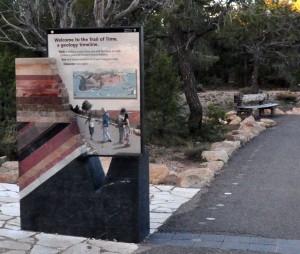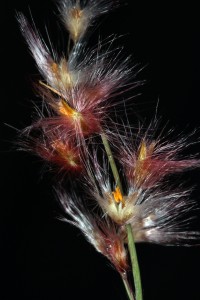One of the most interesting displays in the South Rim of Grand Canyon extends for over a mile along the rim walk There is a sign introducing the path labeled “Two billion years of Grand Canyon History” with an invitation to see and touch some of the rocks. 
One morning I walked the path to Yavapai Point to see the sunrise, and then walked back in the growing beauty of the day. I especially enjoyed seeing samples of the different rock layers. At the 340 million year old mark there is this piece of Redwall limestone. Years ago I learned that the rocks in the red wall are not red but white. The red color comes from thousands of years of iron oxide (rust), washing over the surface. Even so it was rather startling to see how white the “red” wall limestone really is.
Yesterday I had an exciting conference with Jim Verrier. He has invited me to work with him on a book of the grasses of southern Arizona. I brought samples collected a week ago, and he was able to help me put names to grasses that a short time ago were strangers to me. Today I went up to an area called Molino Canyon Vista, just about 5 miles up the Catalina highway. How different it is to walk among the grasses being able to recognize different species and even call them by name. It was a beautiful fall day, as you can see from this picture of an Arizona Sycamore.
One of my last finds turned out to be a grass introduced from South Africa, Natal grass (Melinis repens). This is one I have noticed for many years, since its pink and white flowering heads are so decorative and can be seen for several miles along the highway. One picture shows it all white. The close-up reveals the incredible beauty of the pink and white hairs and the little yellow flowers. Too bad it is an invasive plant. It is really quite lovely.




It has only been in the past 5 years or so that I have become aware of grasses, some growing naturally, some used ornamentally. They are a thrill, for sure, and the soft sound they make, rustling in the wind, is music to my ears.
How lovely that you have become a botanist (and geologist) after being a minister all those years! I seem to have gone in the opposite direction: starting off as a botanist, becoming a microbiologist, and now a minister! Of course, you are still a minister and I am still a scientist.
Thanks Julie:
And I suspect when you retire from being a minister you will find something in your scientific past to keep you interested. Thanks for writing.
Frank